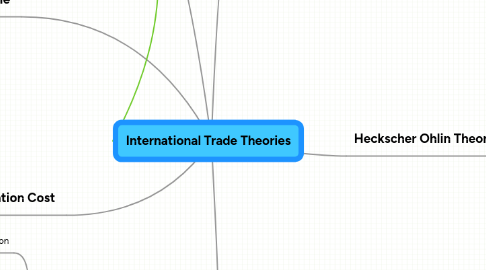
1. Product Life Cycle
1.1. Development & Intro
1.1.1. Advanced nation Monopoly
1.1.2. Sole Exporter
1.2. Trading
1.2.1. Widespread-Techno familiarity Production begins in other nations
1.2.2. Standard Comp. Adv. framework
1.3. Standardized
1.3.1. Introducer loses Comp. Adv
1.3.2. Becomes importer
2. Product Differentiation
2.1. Sim. products same industry/ trade group
2.2. Intra-industry trade
2.2.1. Consumers-Variety
2.2.2. Producers-Economy of Scale
3. Transportation Cost
3.1. Def. Incurred in Transit
3.1.1. Freight
3.1.2. Warehousing
3.1.3. Loading /Unloading
3.1.4. Insurance & Interest
3.2. Invalidate Comparative Advantage
3.2.1. High Costs Restrict Trade
3.2.2. Eg. Perishable Goods
3.3. Adv.
3.3.1. Geographically close nations
3.3.2. Eg. NAFTA
4. Environmental Standards
4.1. Acceptable level of Pollution
4.2. High
4.2.1. Inc. Cost
4.2.2. Red. Comp. Adv.
4.3. Low
4.3.1. Vice Versa
4.3.2. Race to bottom
4.3.3. Inclusions of envi legislations along with red. to barriers of trade.
5. Heckscher Ohlin Theory
5.1. H-O Theorem
5.1.1. Factor Endowment
5.1.1.1. Comparative Advantage
5.1.1.2. Terms of Trade
5.1.2. Export - Abundant Factor
5.1.3. Import- Scarce/expensive factor
5.2. Factor-Price Equalization
5.2.1. International Trade and Specialization
5.2.2. Equalize Relative & Absolute Returns
5.2.3. Homogenous Factors
5.2.4. Stopler Samuelson
5.2.4.1. Inc in Relative price of comodity
5.2.4.2. Inc. Returns on intensively used factor
5.2.4.3. Eg.Labour Abundant
5.2.4.3.1. Price of labour inc.
5.2.4.3.2. Returns on Cap. falls
5.2.5. In each nation
5.2.5.1. Relatively abundant source -expensive
5.2.5.2. Relatively scarce source - cheaper
5.2.6. Implications
5.2.6.1. Worsened Inequality
5.2.6.1.1. Devpd Capital Abundant
5.2.6.1.2. Devpn Labour Abundant
5.2.6.2. True if
5.2.6.2.1. Assumptions of H-O hold
5.2.6.2.2. Stop-Sam is only force in driving changes in inequality
5.3. Empirical Test - Leontief's Paradox
5.3.1. 1951 Tests
5.3.2. Prd. Patterns of trade did not fit the conclusions of H-O.
5.3.3. US Imports - Capital Intensive
5.3.4. Assumptions
5.3.4.1. 2 factor world - capital and labour
5.3.4.2. Consistent Technology b/w nations (w.p)
5.3.4.3. Perfect Mobility b/w factors of production w.p. sector specific factors
5.3.5. Current tests built on Multiple Sector- specific factors
6. Economy of Scale
6.1. Productive relationships
6.1.1. Characterized by inc.returns to scale
6.1.2. Doubling of input more than doubles output
6.1.3. Large scale productions
6.1.4. Lower p.u. cost
6.1.5. Cost Adv. for exports
